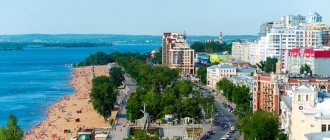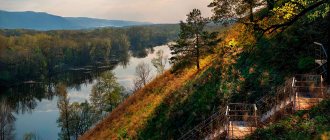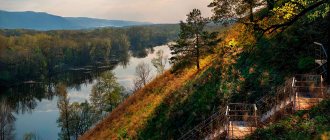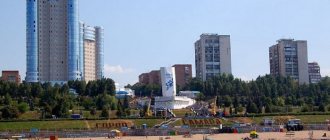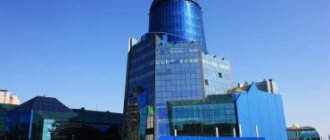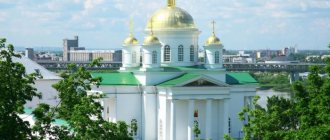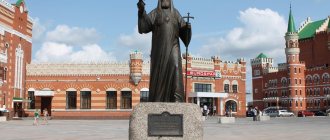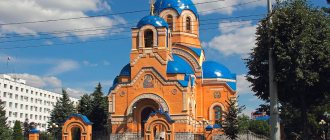Samara is a Russian city with a population of 1.5 million people, located in the Middle Volga region. The old city is located in the bend of the Samara Luka, on the left bank of the Volga River. Along “Mother” it stretches for 50 km, and in width for 20 km. It is one of the largest settlements in the country, with a rich historical and cultural heritage. Let's look at the sights of Samara that are definitely worth seeing.
Brief history of the city
There are several versions of the origin of the city's name. According to one of them, the name Samara is of Turkic origin and is translated as “steppe hand.” According to another opinion, the name is of Greek origin and means “merchant.” Others agree that Samara owes its name to the river of the same name on which it was built. The fortress around the reservoir was erected by order of Tsar Feodor, who once ruled the Russian Empire. The signing of the decree took place in 1753, which is the year the city was founded. In Soviet times (from 1935 to 1991), this cultural center in the Middle Volga region was named Kuibyshev.
Central part of the old city
the main street
European hotel
The career of M. Gorky began in Samara, and the best years of A. N. Tolstoy’s life and work took place here. And these are not all the celebrities born in the Samara corner. Natives and creators are such personalities as I. Repin, V. Surikov, I. Aivazovsky and others. Today, the sights of Samara are open to everyone who wants to visit them and get undeniable pleasure from this process.
History of Samara
“Samara Town” - a settlement with this name was founded on the banks of the Volga in 1586. The order to build the city was issued by Fyodor I the Blessed, who wanted to control the territories through which major trade routes passed. The first memories of the town date back to the 14th century. It is named Samar on the map of merchants from Venice.
Fortress "Samara City"
At first, mostly soldiers lived here. Trade is developing in the city, buildings with defensive walls are being built. In 1688, the city received the status of a district and at the same time the name Samara, which has survived to this day. The number of residents reached several thousand. In 1780, government institutions began to be founded here: courts, treasuries, councils. The development plan for the city territory was approved only in 1782.
Samara in the 19th century
In 1850 Samara became the center of the province. Population: 15,000. This figure increases to 90,000 in just 50 years. Bazaars and large fairs are held here, where residents of neighboring settlements come to sell agricultural products, household items, gold and silver items, and textiles. In 1877, a railway was built through Samara, and the local marina received up to 1000 ships a year. Trade is developing rapidly, the city is being actively built up with merchant palaces and estates, some of which have been preserved in good condition.
Samara in the twentieth century and today
The years 1917-1918 were marked by the establishment of Soviet power here. Since 1935, Samara has been called Kuibyshev. After the collapse of the USSR, the historical name returned. During the Second World War, aircraft manufacturing was actively developing in the city, famous military aircraft and attack aircraft were being assembled. Soon enterprises specializing in the development and creation of rockets appeared. The aerospace industry made a major contribution to the formation of the city's economy.
Today Samara is an important economic, cultural, scientific center in which industry is actively developing. In addition, it is an interesting tourist city with an abundance of modern and historical sites.
Sights of Samara
- Alekseevskaya Square
- Kuibyshev Square
- Chapaev Square
- Opera and Ballet Theatre
- Museum of History and Local Lore
- Samara Space Museum
- Stalin's Bunker Museum
- Drama Theater named after. Gorky
- Actor's House
- Frunze House-Museum
- Theater Monday
- Theater "Samarskaya Square"
- Iversky Convent
- Spaso-Voznesensky Cathedral
- Catholic Church of the Sacred Heart of Jesus
- Monument to the heating battery
- Stella Rook
- Samara railway station
- Samara map
Famous squares in Samara
Alekseevskaya Square
This landmark of Samara is the most iconic place; it is named after the patron saint of Metropolitan Alexy. According to historical information, the creation of this place began with a small lake, which was located in an overgrown clearing.
Alekseevskaya Square
Until 1982, the architectural plan for the development included the construction of a market square. In the traditions of those times, wooden structures soon began to be built around the clearing, acting as trading shops.
Kuibyshev Square
V.V. Kuibyshev is a major statesman and party leader. During Soviet times, the city was renamed in his honor. The famous sculptor Matvey Manizer worked on the creation of this statue.
Kuibyshev Square
On average, the size of the monument is equal to twice the height of a person. The huge figure is presented in a natural pose; the politician is dressed in an ordinary raincoat and work boots.
Chapaev Square
The monument is the main element of the square. It was erected in 1932 by the same architect as the monument to Kuibyshev.
Chapaev Square
In front of this landmark of Samara there is a drama theater, and from the square itself tourists and local residents enjoy stunning views of the Volga River. The monument weighs 12 tons and was transported to the city from Leningrad.
DEMOLISH CANNOT BE LEAVED
More recently, the landscape of the main street of old Samara has been enriched with a new monument. But today we will not talk about him, but about the well-forgotten old one. About those monuments that have been erased from the face of Samara by the inexorable pace of history.
MONUMENT TO ALEXANDER II
Sculptor - Vladimir Sherwood, opening date - 1889. Before the revolution it was the only monument in Samara. In addition to the emperor himself, 4 symbolic figures were added to the composition of the monument: a Russian peasant making the sign of the cross; Circassian breaking a saber; a Bulgarian woman thanking Alexander II for the liberation of her homeland, and a Central Asian woman throwing off her veil.
During the Civil War, the monument disappeared without a trace. In 1927, the leader of the world proletariat took the place of the emperor. Unlike Alexander II, who admired the Volga, Vladimir Ilyich looks towards Leningradskaya.
SCULPTURES OF LENIN AND STALIN NEAR THE OLD RIVER STATION
In 1936, a new comfortable river station was built in Samara, then Kuibyshev. It was located between the Leningradsky and Nekrasovsky descents, closer to the second. The departing citizens were seen off on their good journey not by anyone, but by the leaders themselves - Vladimir Ilyich and Joseph Vissarionovich.
During the fight against the latter’s personality cult, both sculptures were removed out of harm’s way, and in 1969, construction began on a new river station.
MONUMENT “STALIN AND LENIN IN GORKHI”
Let's not go far from the Volga. This is a typical monument that was installed at the Administration of the Volgotanker River Shipping Company on Maxim Gorky Street.
After the debunking of Stalin’s personality cult, he was kicked out of the shop. Vladimir Ilyich remained sitting on it alone, sadly peering into the distance. Rumor has it that some lonely people, exhausted by Narzan, sat down in the vacant seat in order to improve their health in the company of a cultured person. As a result, the monument was completely dismantled.
SCULPTURES OF WARRIORS NEAR THE OFFICERS' HOUSE
The pilot peers into the cloudless Samara sky. Maybe this is Valery Chkalov, after whom the descent to the Volga, a street, an alley and a village in the Kirovsky district are named in Samara. But this is unknown for certain, as is the year of dismantling of these sculptures.
Photo taken from Vladimir Samartsev’s book “Unprecedented Samara”
MONUMENT TO THE THIRD INTERNATIONAL
In a nutshell, the 3rd International is an international organization that united the world's communist parties and existed from 1919 to 1943. In Samara they decided to dedicate a monument to him. But the time was hungry and restless, and therefore the monument was not very large. He represented bent workers holding our blue ball on their muscular shoulders, like Atlases.
By 1932, the monument was almost completely destroyed and was dismantled without pity, and its place was taken by Vasily Chapaev and Co.
FIRST AND SECOND MONUMENTS TO PUSHKIN
We are talking, as you understand, about Pushkin Square. The Alexander Sergeevich who is standing there now is already the third in a row. The first one (pictured left) was installed in 1905, was made of plaster and stood until the mid-1930s. The second, already concrete, appeared here in 1949, and was dismantled for unknown reasons in 1962.
The third coming of Alexander Sergeevich to Pushkin Square occurred in 1985.
A MAN WITH A CHILD IN HIS HANDS
There were at least two copies of the typical Soviet sculpture in Kuibyshev. On the Agriculture Square (on the left) and near the old railway station building.
SCULPTURES OF WORKER AND RED ARMY MEMBER
Photo courtesy of Armen Arutyunov
They were guarding the entrance to the building of the Samara-Zlatoust Railway Administration. They were apparently dismantled during the “thaw” and replaced with flowerpots.
Unfortunately, it was not possible to find close-up photographs of these revolutionary guards, but from what is available, their silhouettes can be seen.
BUSTS OF SAMARA MERCHANTS
On the left is the unveiling of a bust of Anton Shikhobalov near the hospital he built on Sokolnichya Street. It took place in 1909. The construction of the hospital cost A. Shikhobalov 190 thousand rubles. Sokolnichya Street, on which it was located, was renamed Shikhobalovskaya and bore this name before the revolution. The current address of the hospital is st. Leninskaya, 75. It has been under reconstruction for many years, and it is unknown when it will be completed.
On the right is a bust of the merchant Yakov Sokolov next to the almshouse he built. By the way, bronze. Opened on August 21, 1911. The construction of the almshouse cost 200 thousand rubles. For comparison: the famous Kurlina mansion cost ten times less. The current address of the Sokolovskaya almshouse is st. Chkalova, 98. However, now it is not lonely elderly people who spend time there, but the escort department of the GUFSIN.
DOBRYNA AND THE SNAKE
An epic sculptural composition that previously adorned the fountain near the Skazka cafe in the village of Upravlencheskiy. Depicts the epic duel between the hero Dobrynya Nikitich and the filthy Serpent.
Cultural institutions of Samara
Samara's cultural attractions are also vast and varied. Perhaps no other Russian city has such an abundance of theaters, museums and exhibitions as here.
Opera and Ballet Theatre
This landmark of Samara is located on Kuibyshev Square. The greatest architectural monument of the 30s is made in the neoclassical style. The building initially served other purposes and served as a palace of culture; the decision to create a theatrical performance here came only a few years later.
Opera and Ballet Theatre
On the left side there was a library for a long time, and on the right there was a museum and a sports school. In 2006, the building was completely restored.
Museum of History and Local Lore
This is the oldest establishment located in the Volga region. The idea of creating the establishment belonged to the head of the city, P.V. Alabin, who decided to dedicate it to the life and merits of Alexander the Second.
Museum of History and Local Lore
In 1993, the name of this great man was given to the theater itself.
Samara Space Museum
The opening of this Samara attraction took place in 2007, on Cosmonautics Day. Already from the first year of operation, the building turned into a masterpiece.
Museum "Cosmic Samara"
Competitions were held here to determine the most popular attraction. The Soyuz launch vehicle adorns the entire composition.
Stalin's Bunker Museum
Initially, only a few people knew about the existence of this institution, and only in 1991, after giving the city a new name, it was decided to declassify this object.
Museum "Stalin's Bunker"
Foreigners who visit the city of Samara pay special attention to the sights.
Drama Theater named after. Gorky
The history of this cultural building began in 1851, at which time it was created to engage in theatrical activities at a professional level.
Drama theatre
In 1930, a permanent troupe began to operate within the theater, which was located in the theater building created in 1888. The building has two floors and is made of brick; its appearance is reproduced in the original Russian style. In 1977, the theater began to be called academic.
Actor's House
Samara (the city's attractions are numerous) is famous for another interesting place - the acting house, opened in 1973.
Actor's House
At various times, famous cultural figures acted as heads of this institution. Today, this institution has more than 400 actors. Various competitions are held here annually at the regional and international level. New performances are being held within the walls of the institution and far beyond its borders.
Frunze House-Museum
This building was erected in 1891 by a famous Samara architectural figure. Initially, it was planned to make a dormitory here for workers of the pasta factory located next door; a local merchant of the first guild became the first head of the establishment.
Frunze House-Museum
After that, the famous commander Frunze lived in the house for only 1 year.
Theater Monday
Theater Monday
The opening of this attraction of Samara, photos of which can be found in large quantities, occurs in 1998, after one of the troupes left the stage of the academic theater. The actors, left without work and money, decided to prove their own importance and stage a new play.
Theater "Chamber Stage"
The establishment opened in 1993, during which time many interesting performances based on popular classic works were staged. The staff puts a lot of effort into diversifying the program.
Stone Stage Theater
Today the theater is supported by the city administration, which has provided the use of the entire building.
Theater "Samarskaya Square"
The building of this Samara landmark was opened in 1987. After spectators and critics noticed the achievements of the experimental cultural institution, it acquired the status of a municipal entity. The first performance was the plot of “Demonstration”; people learned about it not only in the city, but throughout the country.
Theater Samara Square
The opening of this attraction of Samara, photos of which can be found in large quantities, occurs in 1998, after one of the troupes left the stage of the academic theater. The actors, left without work and money, decided to prove their own importance and stage a new play.
Cultural guide to Samara
Museum and exhibition
Samara
Despite the fact that the Museum and Exhibition Museum is one of the youngest museums in the city, which opened on April 12, 2001, it has managed to become a must-see destination on tourist routes.
It is impossible not to notice the building of the center. On its façade there is a real Soyuz rocket, 68 meters high. This is the only vertically mounted launch vehicle in Europe in assembled form. On the ground floor of the museum there is an exhibition dedicated to the technical equipment of orbital stations, the design of spacecraft and instruments. The next part of the exhibition tells about the daily life of astronauts at the orbital station.
Samara Literary and Memorial Museum named after. M. Gorky
Samara
Literary and Memorial Museum named after. Gorky opened in 1941 in a house on Razin Street (now Frunze Street), where the writer lived. And while studying at the Samara real school, another future writer, Alexei Tolstoy, lived in this house. And it just so happened that most of the exhibitions at the Gorky Museum are dedicated to Alexei Tolstoy.
The furnishings in the writer's memorial apartment recreate the atmosphere of provincial life at the beginning of the last century. Here you can see letters and documents from relatives of Alexei Tolstoy; Antique furniture and other interior items have been preserved.
Museum of Art Nouveau. Mansion A.P. Kurlina
Samara
The Art Nouveau Museum is located in the Kurlina mansion. The mansion was built in 1903 by the merchant of the first guild Kurlin and became one of the first buildings in the Art Nouveau style in Samara.
The museum recreates the atmosphere of the late 19th - early 20th centuries. It was during this period that merchant Samara flourished. The house project was created by architect Alexander Zelenko.
The visitor will also notice the centricity characteristic of Art Nouveau: for example, all the rooms on the first main floor are grouped around the hall. Each of the 22 rooms of the house has its own artistic image. Thus, the dining room is made in an antique style: the ceiling beams are decorated with stucco with images of deities, and the wall tiles are decorated with mythical creatures; the living room is stylized as the Middle Ages.
Samara Academic Drama Theater named after. M. Gorky
Samara
In Samara there is the oldest provincial theater in Russia - the Samara Academic Drama Theater named after. M. Gorky. The first theater troupe began its work back in 1851, with the production of Gogol's The Inspector General. During the Soviet years, the theater was called the Kuibyshev Gorky Drama Theater; in 1977 it became an academic theater.
Today the theater actively tours, films television versions of performances, participates in numerous festivals and itself is their organizer.
House-Museum of V.I. Lenin
Samara
On Leninskaya Street in Samara there is a branch of the Samara Regional Museum of History and Local Lore named after. Alabina – House-Museum of V.I. Lenin. The historical monument of federal significance is located on the territory of a city estate of the late 19th century, preserved almost in its original form.
The house belonged to the Samara merchant Ilya Rytikov, from whom the Ulyanov family rented housing. It was during this period, 1890–1893, that Vladimir Lenin’s worldview was formed, he wrote his first theoretical works and created a Marxist circle.
The house became a museum in 1940, and for Lenin’s centenary in 1970, an exhibition dedicated to the Samara period of his life was organized on the ground floor. On the second floor, the household furnishings of the Ulyanovs’ apartment were reconstructed. Later, during the restoration work, museum services were moved to a neighboring house, connected to Rytikov’s house by an underground passage. This is how a small museum complex was formed.
Cultural and exhibition city Samara
Samara
The cultural and exhibition center opened in Samara in March 1998. You can visit exhibition halls dedicated to ancient civilizations, world painting and see a collection of minerals completely free of charge. Masterpieces of world painting are presented at the Center with digital copies of paintings by Russian and foreign artists. The center operates a photo agency whose task is to photograph picturesque places in Russia and other countries for photo panoramas and photo exhibitions.
House-Museum of M.V. Frunze
Samara
House-Museum named after. M.V. Frunze in Samara opened on February 23, 1934. The museum building was built in 1891, and currently it is a monument of residential architecture.
The museum has three permanent exhibitions. The last of them invites visitors to see materials from 1918–1920, previously hidden under the heading of secrecy. Here you can learn about the confrontation between the armies of Frunze and Kolchak on the Eastern Front, about the anti-Soviet uprising in the rear of the Eastern Front, about desertion in the Red and White Armies and other events during the Civil War.
Holy places in Samara
When considering the city of Samara (attractions, where to go), you should pay attention to the holy places of this city.
Iversky Convent
The creation of this temple dates back to 1850; it initially worked as a community of sisters. Subsequently, the place turned into a small town with three churches located in it - the Iveron Icon of the Mother of God, the Sretensky Cathedral, and women's residential buildings.
Iversky Convent
A significant number of these buildings were destroyed, and the monastery itself had to be closed in 1925.
Spaso-Voznesensky Cathedral
These Samara attractions (see photos with descriptions below) are the most popular, since the temple is popular among tourists and local residents.
Spaso-Voznesensky Cathedral
The construction of the cathedral took place in 1847, since then some restoration work has been carried out here.
Catholic Church of the Sacred Heart of Jesus
Considering the city of Samara, attractions, photos and descriptions, it is worth paying attention to this temple. The Catholic Church of the Sacred Heart of Jesus is one of the most beautiful places in the city.
Catholic Church of the Sacred Heart of Jesus
The most interesting places in this Polish temple are the altar frescoes based on a painting by S. Dali, as well as the Austrian organ.
Other attractions
We described what to see in Samara. The attractions listed above are far from a complete range of interesting places in the city.
Monument to the heating battery
It stands out among other monuments dedicated primarily to military and cultural figures. The monument was created in 2005, because at that time the irreplaceable heating device turned 150 years old.
Monument to the heating battery
The attraction is cast from bronze material and represents a window sill and a cat basking on it.
Stella Rook
The installation of this place was carried out in 1986 and is dedicated to the 400th anniversary of the city. The monument can be seen in the Oktyabrskaya embankment area.
Stella Rook
This stele has huge dimensions and a design thought out to the smallest detail. The attractive appearance of the stele also pleasantly surprises and amazes the eyes of every tourist.
Samara railway station
The building is the tallest in Europe among other stations, its height is more than 100 meters. A modern, comfortable building welcomes guests and forms the first impression of this wonderful cultural city.
Railway station
So, we looked at what the city of Samara contains, attractions, photos, memorable places. While walking along the streets, do not forget to visit these places to see a beautiful panorama, breathe in the “cultural” air and feel the flavor of the city. On the map, memorable places are indicated in more detail.
